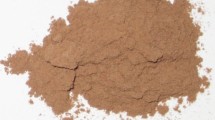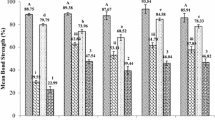Abstract
The formaldehyde-free tannin adhesive (AcBTanGlu) was synthesized by bark extractives of Acacia confusa and hexamethylenetetramine, and was further used for production of the oriented bamboo scrimber board (OBSB) in this study. When Acacia bark extract tannins are mixed with 2% hexamethylenetetramine, the OBSB pressed at a hot pressing temperature of 150 °C for 15 min can obtain the maximum mechanical strength. The tap tone velocity (Vt), ultrasonic-wave velocity (Vu), dynamic modulus of elasticity (DMOEu), dynamic modulus of tap tone velocity (DMOEt), screw holding strength (SHS), and dimensional stability of AcBTanGlu glued OBSB are significantly higher than those of UF and PF glued ones. AcBTanGlu glued OBSB also has higher modulus of elasticity (MOE)(//) and modulus of rupture (MOR)(//) values than the parallel structure laminated bamboo board (LBB) and laminated beams made with whole moso bamboo (Phyllostachys pubescens). The 12-week decay test with L. betulina and L. sulphureus showed no significant difference between OBSB glued by AcBTanGlu and UF (p > 0.05). The results of this study will help the bamboo processing industry to gain an understanding of the properties of AcBTanGlu glued OBSB.



Similar content being viewed by others
References
Abdullah UHB, Pizzi A (2013) Tannin-furfuryl alcohol wood panel adhesives without formaldehyde. Eur J Wood Prod 71:131–132
Barnes HM (2012) Durable composites: an overview. Am Wood Prot Assoc (AWPA) 107:267–279
Cheng D, Jiang S, Zhang Q (2013) Effect of hydrothermal treatment with different aqueous solutions on the mold resistance of moso bamboo with chemical and FTIR analysis. BioResources 8:371–382
Chung MJ, Wang SY (2017) Effects of peeling and steam-heating treatment on Basic properties of Phyllostachys makinoi and Phyllostachys pubescens culms. J Wood Sci 63(5):473–482. https://doi.org/10.1007/s10086-017-1647-y
Chung MJ, Wang SY (2018a) Mechanical properties of oriented bamboo scrimber boards made of Phyllostachys pubescens (moso bamboo) from Taiwan and China as a function of density. Holzforschung 72(2):151–158. https://doi.org/10.1515/hf-2017-0084
Chung MJ, Wang SY (2018b) Effects of peeling and steam-heating treatment on mechanical properties and dimensional stability of oriented Phyllostachys makinoi and Phyllostachys pubescens scrimber boards. J Wood Sci 64(5):625–634. https://doi.org/10.1007/s10086-018-1731-y
Chung MJ, Chang TC, Chang ST, Wang SY (2021) Properties of a formaldehyde-free tannin adhesive and mechanical strength of oriented bamboo scrimber board bonded with it. Holzforschung 75(1):91–100. https://doi.org/10.1515/hf-2019-0267
CNS 11031 (2014) Structural glued-laminated timber. Bureau of Standards, Metrology and Inspection, Ministry of Economic Affairs (MOEA), Taipei, Taiwan
CNS 6717 (2011). Qualitative standards and testing methods of wood preservatives. Bureau of Standards, Metrology and Inspection, Ministry of Economic Affairs (MOEA), Taipei, Taiwan
Jain S, Kumar R (1992) Mechanical behavior of bamboo and bamboo composites. J Mater Sci 27:4598–4604
Kamoun C, Pizzi A (2000a) Mechanism of Hexamine as a non-aldehyde polycondensation resins hardener. Part 1: hexamine decomposition and reactive intermediates. Holzforsch Holzverwert 52(1):16–19
Kamoun C, Pizzi A (2000b) Mechanism of hexamine as a non-aldehyde polycondensation hardener. Part 2: recomposition of intermediate reactive compounds. Holzforsch Holzverwert 52(3):66–67
Kamoun C, Pizzi A, Zaneiti M (2003) Upgrading of MUF resins by buffering additives—part 1: hexamine sulphate effect and its limits. J Appl Polym Sci 90(1):203–214
Kojima Y, Suzuki S (2011) Evaluating the durability of wood-based panels using internal bond strength results from accelerated aging treatments. J Wood Sci 57:7–13. https://doi.org/10.1007/s10086-010-1131-4
Lai CH (2004) The properties of oriented strand board made of Taiwania cryptomerioides thinning timbers. Dissertation, National Taiwan University
Lee CH, Chung MJ, Lin CH, Yang TH (2012) Effects of layered structure on the physical and mechanical properties of laminated moso bamboo (Phyllosachys edulis) flooring. Constr Build Mater 28:31–35
Lee CJ, Yang TH (2010) Evaluation of bending properties of China fir laminae using nondestructive testing. Q J Forest Res 32(4):45–60 (in Chinese)
Lee AWC, Bai X, Peralta PN (1996) Physical and mechanical properties of strandboard made from moso bamboo. Forest Prod J 46:84–88
Li XB (2004) Physical, chemical, and mechanical properties of bamboo and its utilization potential for fiberboard manufacturing. Dissertation, Louisiana State University
Li WJ, Lan WC (2006) Laminated beams made with whole bamboo. Q J For Res 28(3):83–90 (in Chinese)
Liu CT, Lii WJ, Wang YH (1992) Laminated bamboo and wood for high value-added products and construction materials (I) The physical-mechanical properties and gluability of bamboo. For Prod Ind 11(1):19–29 (in Chinese)
Liu CT, Lii WJ, Wang YH (1993) Laminated bamboo for high value-added products-the properties of adhesives used in laminated bamboo and the development of their bonding strength. For Prod Ind 12(3):51–64 (in Chinese)
Makino R, Ohara S, Hashida K (2011) Radical scavenging characteristics of condensed tannins from barks of various tree species compared with quebracho wood tannin. Holzforschung 65(5):651–657
Moubarik A, Allal A, Pizzi A, Charrier F, Charrier B (2010) Characterization of a formaldehyde-free cornstarch-tannin wood adhesive for interior plywood. Eur J Wood Prod 68(4):427–433. https://doi.org/10.1007/s00107-009-0379-0
Okubo K, Fujii T, Yamamoto Y (2004) Development of bamboo based polymer composites and their mechanical properties. Compos Part A Appl S 35:377–383. https://doi.org/10.1016/j.compositesa.2003.09.017
Pichelin F, Kamoun C, Pizzi A (1999) Hexamine hardener behaviour: effects on wood glueing, tannin and other wood adhesives. Holz Roh Werkst 57:305–317
Pichelin F, Nakatani M, Pizzi A, Wieland S, Despres A, Rigolet S (2006) Structural beams from thick wood panels bonded industrially with formaldehyde-free tannin adhesives. For Prod J 56(5):31–36
Pizzi A (2006) Recent developments in eco-efficient bio-based adhesives for wood bonding: opportunities and issues. J Adhes Sci Technol 20(8):829–846
Pizzi A, Tekely P (1995) Mechanism of polyphenolic tannin resin hardening by hexamethylenetetramine: CP–MAS 13C-NMR. J Appl Polym Sci 56(12):1645–1650
Pizzi A, Tekely P (1996) Hardening mechanisms by hexamethylenetetramine of fast-reacting phenolic wood adhesives—a CP-MAS 13C NMR study. Holzforschung 50(3):277–281
Pizzi A, Tekely P, Pananigama LA (1996) A different approach to low formaldehyde emission aminoplastic wood adhesives. Holzforschung 50(5):481–485
Sharma B, Gatóo A, Ramage M (2015b) Effect of processing methods on the mechanical properties of engineered bamboo. Constr Build Mater 83:95–101. https://doi.org/10.1016/j.conbuildmat.2015.02.048
Sharma B, Gatóo A, Bock M, Ramage M (2015a) Engineered bamboo for structural applications. Constr Build Mater 81:66–73. https://doi.org/10.1016/j.conbuildmat.2015.01.077
Verma CS, Chariar VM (2012) Development of layered laminate bamboo composite and their mechanical properties. Compos Part B Eng 43:1063–1069. https://doi.org/10.1016/j.compositesb.2011.11.065
Wang JX (1989) Bamboo scrimber: novel technology and novel product. China Wood Ind 3:52–53
Wang SY, Chen JH, Tsai MJ, Lin CJ, Yang TH (2008) Grading of softwood lumber using non-destructive techniques. J Mater Process Technol 208:149–158. https://doi.org/10.1016/j.jmatprotec.2007.12.105
Yu WJ, Yu YL (2013) Development and prospect of wood and bamboo scrimber industry in China. China Wood Ind 27:5–8
Yu Y, Zhu R, Wu B, Hu Y, Yu W (2015) Fabrication, material properties, and application of bamboo scrimber. Wood Sci Technol 49:83–98. https://doi.org/10.1007/s00226-014-0683-7
Acknowledgements
This study was supported by a Grant from the Experimental Forest, College of Bioresource and Agriculture, National Taiwan University, Taiwan, ROC (Grant No. 109-C02). We would like to thank Dr. David Sheng-Yang Wang, whose advice on experimental design and help with subsequent analysis was invaluable.
Author information
Authors and Affiliations
Corresponding author
Additional information
Publisher's Note
Springer Nature remains neutral with regard to jurisdictional claims in published maps and institutional affiliations.
Supplementary Information
Below is the link to the electronic supplementary material.
Rights and permissions
About this article
Cite this article
Lee, CJ., Chang, TC. & Chung, MJ. Effects of gluing conditions for formaldehyde-free tannin adhesive on the oriented bamboo scrimber board properties. Eur. J. Wood Prod. 79, 1623–1631 (2021). https://doi.org/10.1007/s00107-021-01701-6
Received:
Accepted:
Published:
Issue Date:
DOI: https://doi.org/10.1007/s00107-021-01701-6




